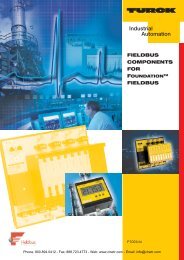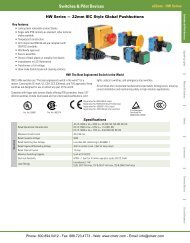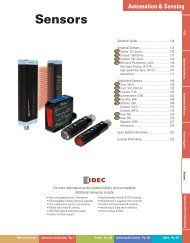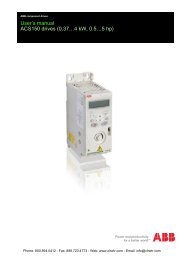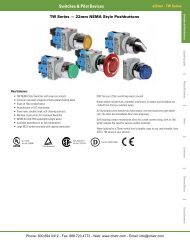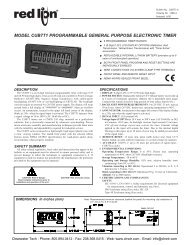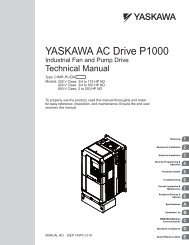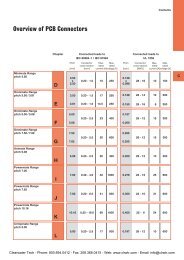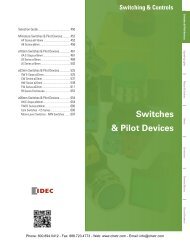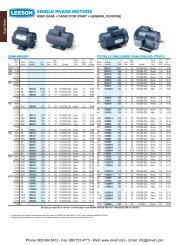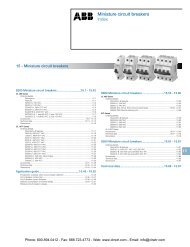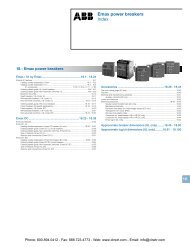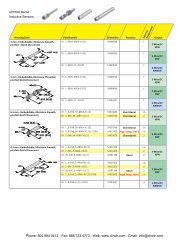LEESON R Series Helical-Inline Gear Reducers
LEESON R Series Helical-Inline Gear Reducers
LEESON R Series Helical-Inline Gear Reducers
You also want an ePaper? Increase the reach of your titles
YUMPU automatically turns print PDFs into web optimized ePapers that Google loves.
“HOW TO USE” QUICK SELECTIONS<br />
R SERIES & P SERIES HELICAL-INLINE<br />
How To Use<br />
Quick Selections<br />
Maximum Rating Tables for Cast Iron Double,<br />
Triple and Quad Reduction <strong>Gear</strong> <strong>Reducers</strong><br />
start on page 429. Aluminum maximum<br />
rating tables start on page 40.Selection of the<br />
appropriate gear reducer can be made using<br />
those tables or the Quick Selections on the<br />
following pages.<br />
BEFORE YOU START:<br />
Identify the Service Factor of the application.<br />
Determine the actual input horsepower of the<br />
motor by multiplying the motor’s nameplate<br />
horsepower by the Service Factor.<br />
Determine the output speed (RPM) required at<br />
output shaft of reducer.<br />
Identify the mounting style required by your<br />
application from the style charts shown on<br />
pages 390-391 or 458. Note the different<br />
bases and flanges to interchange with various<br />
competitive units.<br />
To select the proper gear reducer size, use<br />
the Quick Selections as shown:<br />
STOCK GEAR+MOTOR<br />
Start with a reducer and add a <strong>LEESON</strong><br />
industrial-duty NEMA C face motor to produce<br />
a <strong>Gear</strong>+Motor .<br />
A wide variety of single phase, three phase<br />
and DC motors—suitable for almost every<br />
industrial application need––have been<br />
pre-selected and assembled to reducers to<br />
provide a variety of torque and output speed<br />
combinations…ready for shipment. Saves<br />
time and expense.<br />
<strong>Helical</strong> - <strong>Inline</strong><br />
<strong>Gear</strong> <strong>Reducers</strong><br />
1 Find the appropriate Quick Selections<br />
page. The tables begin on page<br />
393 and are organized by motor HP.<br />
The reducer should be selected first;<br />
GEAR+MOTOR combinations follow.<br />
5 Check load capacities against the needs<br />
of your application. Do not exceed the<br />
overhung load (OHL) shown in the table.<br />
Detailed instructions for calculating the<br />
actual overhung load are shown on page<br />
659. If overhung and thrust loads will<br />
be applied simultaneously or if the load<br />
exceeds listed capacities, contact Factory.<br />
2 Locate output RPM column on left side of the<br />
table. All ratings are based on an input speed<br />
of 1750 RPM. Scroll down to the output speed<br />
(RPM) required. Output speeds are rounded<br />
to the nearest whole number. For exact output<br />
speed, divide 1750 by the ratio listed.<br />
3 Choose aluminum or cast<br />
iron construction.<br />
4 Move to the Service Factor<br />
column and find one suitable to<br />
meet the application requirements.<br />
Refer to page 658 for AGMA<br />
recommended service factors.<br />
8 Identify reducer mounting<br />
position on page 478-479.<br />
6 Select motor<br />
frame size.<br />
7 Identify the catalog number<br />
of the reducer by continuing<br />
to the right. See page 389 for<br />
detailed information on building<br />
an exact catalog number. The<br />
B1 suffix can be replaced with<br />
optional Mod-Squad codes as<br />
detailed on page 389.<br />
9 Verify physical dimensions<br />
using the dimensional drawings<br />
shown on pages 444-455 or<br />
474.<br />
10 Add a motor<br />
Phone: 800.894.0412 - Fax: 888.723.4773 - Web: www.clrwtr.com - Email: info@clrwtr.com



